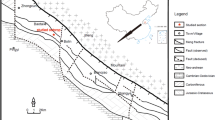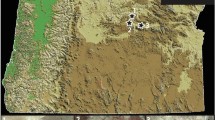Abstract
The stable carbon isotope composition of CO2 occluded in the gibbsite structure is proposed as a potential atmospheric paleo-PCO2 proxy. Analysis of pedogenic gibbsite from a modern Ultisol in the Piedmont of Georgia, USA, was conducted to test the basis for this concept and to help constrain the parameters used to describe physical and biological processes affecting such factors as the respiration rate of CO2. Co-variation of the δ13C and δ18O values with depth along a gradient parallel to the mixing line between the atmosphere and the soil organic material implies that diffusion is the process that determines the stable isotope composition of soil CO2. In the upper 40 cm, the measured δ13C values are not consistent with the expected diffusive depth profile assumed in paleo-PCO2 models. The isotope signature is reset downward in the depth profile with a concentration of the most atmosphere-like δ13C and δ18O values occurring at the top of the Bt horizon by some as-yet-unknown process. Bioturbation, recrystallization, and physical translocation are potential explanations for this observation. Regardless of the process at work, the net effect is an apparent two-component mixing curve between the top of the Bt horizon and deep within the saprolite. In cases where the A horizon is eroded but the Bt horizon is preserved it is possible that δ13C values of gibbsite-occluded CO2 can serve as a proxy for atmospheric paleo-PCO2. Careful textural study of all paleosols is therefore essential to match stable carbon isotope signatures with the horizons preserved. Understanding of modern dynamics and preservation of these isotopic signatures may also be important for those that employ other carbonate proxies.
Similar content being viewed by others
Explore related subjects
Discover the latest articles, news and stories from top researchers in related subjects.References
Austin, J.C. (2011) Soil CO2 efflux simulations using Monte Carlo method and implications for recording paleo-atmospheric PCO2 in pedogenic gibbsite. Palaeogeography Palaeoclimatology Palaeoecology, 305, 280–285.
Bacon, A.R., Richter, D.D., Bierman, P., and Rood, D.H. (2012) Coupling meteoric 10Be with pedogenic losses of 9Be to improve soil residence time estimates on an ancient North American interfluve. Geology, 40, 847–850.
Berner, R.A. and Kothavala, Z. (2001) GEOCARB III: A revised model of atmospheric CO2 over Phanerozoic time. American Journal of Science, 301, 182–204.
Bowen, G.J. and Beerling, D.J. (2004) An integrated model for soil organic carbon and CO2: Implications for paleosol carbonate pCO2 paleobarometry. Global Biogeochemical Cycles, 18, GB1026 1021–1012.
Breecker, D.O., Sharp, Z.D., and McFadden, L.D. (2009) Seasonal bias in the formation and stable isotopic compostition of pedogenic carbonate in modern soils from central New Mexico, USA. Geological Society of America Bulletin, 121, 630–640.
Cerling, T.E. (1984) The stable isotopic composition of modern soil carbonate and its relationship to climate. Earth and Planetary Science Letters, 71, 229–240.
Cerling, T.E. (1991) Carbon dioxide in the atmosphere: evidence from Cenozoic and Mesozoic Paleosols. American Journal of Science, 291, 377–400.
Cerling, T.E., Quade, J., and Bowman, J.R. (1989) Carbon isotopes in soils and palaeosols as ecology and palaeoecology indicators. Nature, 341, 138–139.
Chen, Q., Zhu, R., and Xu, H. (2013) Stable isotopes of carbon dioxide in the marine atmosphere along a hemispheric course from China to Antartica. Atmospheric Environment, 80, 342–346.
Cuntz, M., Ciais, P., Hoffmann, G., and Knorr, W. (2003) A comprehensive global three-dimensional model of δ18O in atmospheric CO2: 1. Validation of surface processes. Journal of Geophysical Research, 108, 4528, doi: 10.1029/2002JD003153.
Farrimond, P., Eglinton, G., and Brassell, S.C. (1986) Alkenones in Cretaceous black shales, Blake-Bahama Basin, western North Atlantic. Organic Geochemistry, 10, 897–903.
Francey, R.J., Allison, C.E., Etheridge, D.M., Trudinger, C.M., Enting, I.G., Leuenberger, M., Langerfelds, R.L., Michel, E., and Steele, L.P. (1999) A 1000-year high precision record of δ13C in atmospheric CO2. Tellus, 51B, 170–193.
Freeman, K.H. and Hayes, J.M. (1992) Fractionation of carbon isotopes by phytoplankton and estimates of ancient CO2 levels. Global Biogeochemical Cycles, 6, 185–198.
Hesterberg, R. and Siegenthaler, U. (1991) Production and stable isotopic composition of CO2 in a soil near Bern, Switzerland. Tellus, 43B, 197–205.
Hsieh, J.C.C., Savin, S.M., Kelly, E.F., and Chadwick, O.A. (1998) Measurement of soil-water δ18O values by direct equilibration with CO2. Geoderma, 82, 255–268.
Kump, L.R. and Arthur, M.A. (1999) Interpreting carbonisotope excursions: carbonates and organic matter. Chemical Geology, 161, 181–198.
Kurschner, W.M., Van Der Burgh, J., Visscher, H., and Dilcher, D.L. (1996) Oak leaves as biosensors of late Neogene and early Pleistocene paleoatmospheric CO2 concentrations. Marine Micropaleontology, 27, 299–312.
Marlowe, I.T., Brassell, S.C., Eglinton, G., and Green, J.C. (1990) Long-chain alkenones and alkyl alkenoates and the fossil coccolith record of marine sediments. Chemical Geology, 88, 349–375.
Miller, J.B., Yakir, D., White, J.W.C., and Tans, P.P. (1999) Measurement of 18O/16O in the soil-atmosphere CO2 flux. Global Biogeochemical Cycles, 13, 761–774.
Pagani, M., Freeman, K.H., and Arthur, M.A. (1999) Late Miocene atmospheric CO2 concentrations and the expansion of C4 grasses. Science, 285, 876–879.
Robertson, S.M. (1968) Soil Survey of Clarke and Oconee Counties, Georgia. Department of Agriculture, U.S.A.
Royer, D.L., Berner, R.A., and Beerling, D.J. (2001) Phanerozoic atmospheric CO2 change: evaluating geochemical and paleobiological approaches. Earth Science Reviews, 54, 349–392.
Schroeder, P.A. and Melear, N.D. (1999) Stable carbon isotope signatures preserved in authigenic gibbsite from a forested granitic-regolith: Panola Mountain, Georgia, USA. Geoderma, 91, 261–279.
Schroeder, P.A., Melear, N.D., Bierman, P., Kashgarian, M., and Caffee, M.W. (2001) Apparent gibbsite growth ages for regolith in the Georgia Piedmont. Geochimica et Cosmochimica Acta, 65, 381–386.
Schroeder, P.A., Austin, J.C., and Dowd, J.F. (2006) Estimating long-term soil respiration rates from carbon isotopes occluded in gibbsite. Geochimica et Cosmochimica Acta, 70, 5692–5697.
Stern, L., Baisden, W.T., and Amundson, R. (1999) Processes controlling the oxygen isotope ratio of soil CO2: Analytic and numerical modeling. Geochimica et Cosmochimica Acta, 63, 799–814.
Su, C.M. and Suarez, D.L. (1997) In situ infrared speciation of absorbed carbonate on aluminum and iron oxide. Clays and Clay Minerals, 45, 814–825.
Tabor, N.J. and Yapp, C.J. (2005) Incremental vacuum dehydration-decarbonation experiments on a natural gibbsite (α-Al(OH)3): CO2 abundance and δ13C values. Geochimica et Cosmochimica Acta, 69, 519–527.
Van Der Burgh, J., Visscher, H., Dilcher, D.L., and Kurschner, W.M. (1993) Paleoatmospheric signatures in Neogene fossil leaves. Science, 260, 1788–1790.
Welp, L.R., Keeling, R.F., Meijer, H.A.J., Bollenbacher, A.F., Piper, S.C., Yoshimura, K., Francey, R.J., Allison, C.E., and Wahlen, M. (2011) Interannual variability in the oxygen isotopes of atmospheric CO2 driven by El Nino. Nature, 477, 579–582.
Woodward, F.I. and Bazzaz, F.A. (1988) The responses of stomatal density to CO2 partial pressure. Journal of Experimental Botany, 39, 1771–1781.
Yapp, C.J. (1997) An assessment of isotopic equilibrium in goethites from a bog iron deposit in a lateritic regolith. Chemical Geology, 135, 159–171.
Yapp, C.J. (2003) A model for 18O/16O variations in CO evolved from goethite during the solid-state α-FeOOH to α-Fe2O3 phase transition. Geochimica et Cosmochimica Acta, 67, 1991–2004.
Yapp, C.J. and Poths, H. (1986) Carbon in natural goethites. Geochimica et Cosmochimica Acta, 50, 1213–1220.
Yapp, C.J. and Poths, H. (1990) Infrared spectral evidence for a minor Fe(III) carbonate bearing component in natural goethite. Clays and Clay Minerals, 38, 442–444.
Yapp, C.J. and Poths, H. (1992) Ancient atmospheric CO2 pressures inferred from natural goethites. Nature, 355, 342–344.
Yapp, C.J. and Poths, H. (1996) Carbon isotopes in continental weathering environments and variations in ancient atmospheric CO2 pressure. Earth and Planetary Science Letters, 137, 71–82.
Author information
Authors and Affiliations
Corresponding author
Rights and permissions
About this article
Cite this article
Austin, J.C., Schroeder, P.A. Assessment of Pedogenic Gibbsite as a Paleo-PCO2 Proxy Using a Modern Ultisol. Clays Clay Miner. 62, 253–266 (2014). https://doi.org/10.1346/CCMN.2014.0620402
Received:
Revised:
Published:
Issue Date:
DOI: https://doi.org/10.1346/CCMN.2014.0620402




